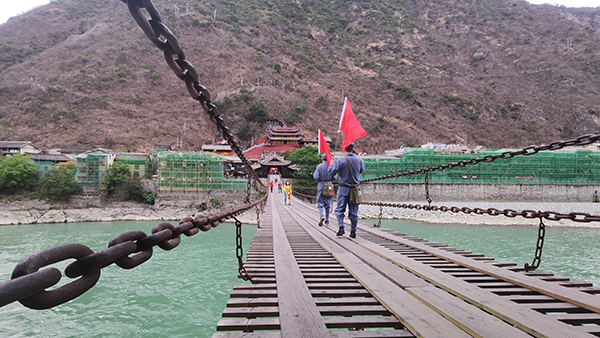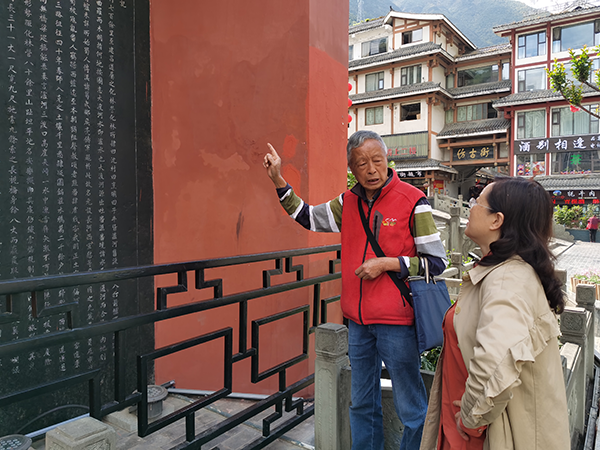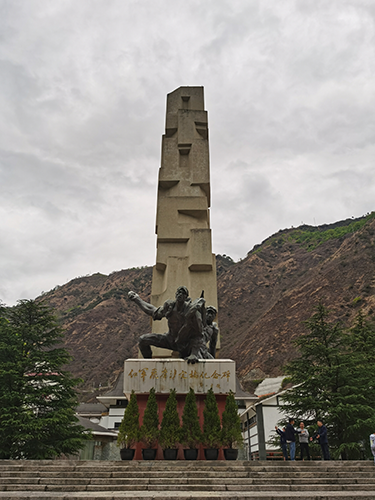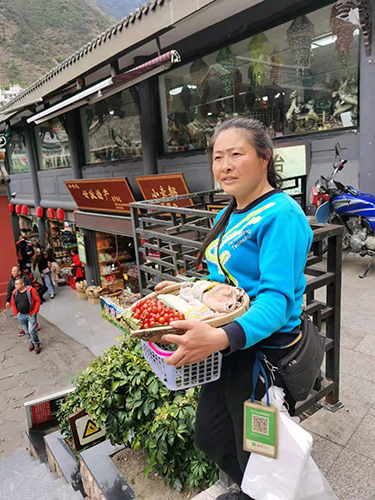
People dressed in Red Army uniforms cross the Luding Bridge in the Ganzi Tibetan autonomous prefecture in Sichuan province. [Photo by HUANG LERAN/FOR CHINA DAILY]
Crossing's significance in red lore has turned the area into a popular attraction, Huang Zhiling reports in Luding, Sichuan.
Since March, the number of tourists visiting the Luding Bridge in the Ganzi Tibetan autonomous prefecture in Sichuan province has been increasing.
"Each day, between 1,000 and 2,000 people arrive. For safety concerns, only between 80 and 100 people are permitted to be on the bridge at the same time," says Li Yuanjiao, an administrator in charge of the bridge.
The surge in the number of tourists has much to do with the upcoming 100th anniversary of the founding of the Communist Party of China on July 1, as the bridge reminds people of its important historical moments.
Every Chinese person has learned of the bridge's importance from history books at a young age. During the Long March 86 years ago, the bridge was crucial to the survival of the CPC-led Red Army.
The Long March began as a retreat from Ruijin in Jiangxi province where the Provisional Central Government of the Soviet Republic of China was set up in 1931.
The central Soviet area had to be abandoned in 1934 after the Red Army failed to break through the one-year-long fifth campaign launched by Kuomintang leader Chiang Kai-shek.
Chiang built blockhouses with machine guns to block all routes out of the area. But the Red Army managed to find a way out of the blockade.
Initially, the evacuation of 86,000 people was in shambles. Disorganized and ill-equipped, the first lap of the Long March was accomplished at an enormous cost, with the army fighting every inch of the way. Some 50,000 soldiers lost their lives in the Battle of the Xiangjiang River at the junction of Hunan province and today's Guangxi Zhuang autonomous region.
At an important meeting in Zunyi in Guizhou province, Chairman Mao Zedong emerged as the leader. The march was transformed from a flight in disarray into a call to arms against Japanese aggression. It also led to a base in Yan'an in Shaanxi province via Sichuan.

Sun Guangjun, former chairman of the Luding county committee of the Chinese People's Political Consultative Conference, tells visitors about the history of the Luding Bridge. [Photo by HUANG LERAN/FOR CHINA DAILY]
Going northwest, the Long Marchers slowly moved toward their destination. Brilliant maneuvers threw the Kuomintang troops off the scent. The Red Army advanced, doubled back, wheeled round and resumed its forward thrust. In May 1935, the army reached the Sichuan border.
The route passed through the region of the ethnic Yi people. They were persuaded into granting the Red Army a safe passage through their mountainous homeland thanks to Red Army commander Liu Bocheng. The native Sichuanese convinced the Yi chieftain that the Red Army aimed at peaceful coexistence with, not oppression of, ethnic groups.
Liu swore blood brotherhood with the Yi chieftain, sealing his oath in the tribal tradition with a drink of chicken blood.
The next hurdle was Dadu River. Crossing it was to be the single most critical action of the Long March.
Leaving the Yi area, the Red Army soldiers seized the Kuomintang-controlled Anshunchang Ferry in Shimian county, Sichuan, and found four boats.
Chiang had hoped that Anshunchang would be the site the Red Army would repeat the tragedy of Shi Dakai, one of the brilliant generals of the Taiping Rebellion which almost toppled the Qing Dynasty (1644-1911), the last feudal dynasty in China.
In May 1863, Shi and his soldiers reached Anshunchang after entering Sichuan from neighboring Yunnan province.
Due to the sudden surge in the water level of Dadu River because of a rainstorm, Shi and his men were blocked in the south of the river. To save his soldiers from death, he went to the Qing military camp, pledging to sacrifice his own life.
While 4,000 Taiping soldiers were sent away by the Qing military, some 2,000 were killed and Shi himself was sent to the Sichuan provincial capital of Chengdu to be sentenced to death.
A monument on Chunxi Road, which is the busiest commercial street in Chengdu, is at the site where Shi died from a thousand sword slashes.

The Luding Bridge Monument with inscriptions by former leader Deng Xiaoping. [Photo by HUANG LERAN/FOR CHINA DAILY]
When the Red Army came to Dadu River that same month 72 years later, the current was too swift and the progress of ferrying the soldiers in four boats was too slow.
Mao convened a meeting which decided to seize the Kuomintang-controlled Luding Bridge 160 kilometers away.
Sun Guangjun, former chairman of the Luding county committee of the Chinese People's Political Consultative Conference, says the soldiers marched a gruesome and exhausting 120 km in a single day on May 28, 1935.
At 6 am the next day, they reached the west bank of the bridge on Dadu River and found the planks had been removed from the bridge and only 13 iron chains remained.
Kuomintang troops were converging on the east bank to cut the Red Army soldiers off. Seizure of the bridge on May 29 became a heroic incident of a story filled with heroes.
"Victory is life, defeat is certain death," said Red Army general Peng Dehuai.
The Red Army controlled a temple on the west bank which is much higher than the east bank. Under the cover of cannons and machine guns from the temple, 22 soldiers clung to the iron chains of the bridge, laying planks on it under intense machine gun fire from Kuomintang troops on the other side of the bridge.
With several soldiers becoming injured and falling into the ferocious Dadu River, they crawled ahead on the planks they had laid, firing gunshots and launching a torrent of grenades until they finally took control of the east bank.
"Today, people only know the names of four soldiers though many others sacrificed their lives in ensuring battles," says Sun, an expert in CPC history.
"Twenty-two pillars stand in the Luding Bridge Memorial Museum in honor of the 22 brave men. While four of the pillars are engraved with the names of those who battled so hard, 18 remain blank, their names unknown forever."
When Mao met Edgar Snow, the American journalist who wrote the book Red Star over China in Yan'an in 1936, he said the Red Army's forced crossing of Dadu River was the most important event in the Long March.

A woman in Luding county sells cherries on the west bank of the Luding Bridge. [Photo by HUANG LERAN/FOR CHINA DAILY]
If the forced crossing had failed, the Red Army might have been wiped out, reads an exhibit in the museum with this quote from Mao.
The Luding Bridge Square is less than a minute walk from the east bank of the bridge and is the center of the Luding county seat. When night falls, the square is crowded with women dancing in groups. During the day, visitors can see Luding Bridge flanked by two highways from a distance.
Built in 1706 during the reign of Qing Emperor Kangxi, the entrance has the words Luding Bridge in the calligraphy of the emperor.
It was the only bridge crossing Dadu River in ancient times, and it was an important link on the ancient Tea Horse Road. Porters carrying tea to Tibetan-inhabited areas had to cross the bridge.
As so many porters passed the bridge, holes drilled with sticks used to support them can be seen on its west bank.
The 81-km-long Luding county section of Dadu River now has 23 bridges-19 highway bridges and four cable suspension bridges.
As locals have convenient transportation facilities, it takes them only three hours to drive from Luding Bridge to Anshunchang. But local farmers still retain the tradition of peddling fruits in the streets.
As it is the red cherry harvest season, farmers selling cherries in bamboo baskets are ubiquitous. One kilogram of cherries is sold for only 10 yuan ($1.50) on average.
Because cherry trees are in different parts of the mountainous county, people in Luding have cherries until June when the fruit on the high mountains is ripe, says Luo Chukai, an information officer with the Luding county committee of the CPC.
A cherry festival made its debut in the county on April 17, drawing visitors from different parts of the country to taste the fruit and walk on Luding Bridge.
Guo Yurong, a rural resort owner, says all the 31 star-related rural hotels and resorts in the county are full of visitors tasting cherries as well as fresh local dishes made of chicken, bacon, beans and edible wild herbs.
Each resort has cherry trees and visitors can pick the fruit from trees and eat it free of charge and to their hearts' content, she says.

